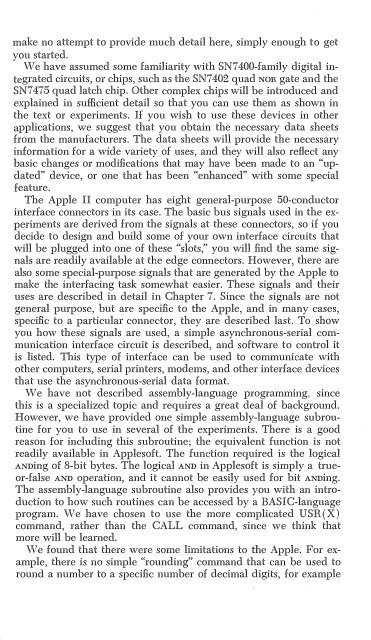Create successful ePaper yourself
Turn your PDF publications into a flip-book with our unique Google optimized e-Paper software.
make no attempt to provide much detail here, simply enough to get<br />
you started.<br />
We have assumed some familiarity with SN7400-family digital integrated<br />
circuits, or chips, such as the SN7 402 quad NOR gate and the<br />
SN7475 quad latch chip. Other complex chips will be introduced and<br />
explained in sufficient detail so that you can use them as shown in<br />
the text or experiments. If you wish to use these devices in other<br />
applications, we suggest that you obtain the necessary data sheets<br />
from the manufacturers. The data sheets will provide the necessary<br />
information for a wide variety of uses, and they will also reflect any<br />
basic changes or modifications that may have been made to an "updated"<br />
device, or one that has been "enhanced" with some special<br />
feature.<br />
The Apple II computer has eight general-purpose 50-conductor<br />
interface connectors in its case. The basic bus signals used in the experiments<br />
are derived from the signals at these connectors, so if you<br />
decide to design and build some of your own interface circuits that<br />
will be plugged into one of these "slots," you will find the same signals<br />
are readily available at the edge connectors. However, there are<br />
also some special-purpose signals that are generated by the Apple to<br />
make the <strong>interfacing</strong> task somewhat easier. These signals and their<br />
uses are described in detail in Chapter 7. Since the signals are not<br />
general purpose, but are specific to the Apple, and in many cases,<br />
specific to a particular connector, they are described last. To show<br />
you how these signals are used, a simple asynchronous-serial communication<br />
interface circuit is described, and software to control it<br />
is listed. This type of interface can be used to communicate with<br />
other computers, serial printers, modems, and other interface devices<br />
that use the asynchronous-serial data format.<br />
We have not described assembly-language programming, since<br />
this is a specialized topic and requires a great deal of background.<br />
However, we have provided one simple assembly-language subroutine<br />
for you to use in several of the experiments. There is a good<br />
reason for including this subroutine; the equivalent function is not<br />
readily available in Applesoft. The function required is the logical<br />
ANDing of 8-bit bytes. The logical AND in Applesoft is simply a trueor-false<br />
AND operation, and it cannot be easily used for bit ANDing.<br />
The assembly-language subroutine also provides you with an introduction<br />
to how such routines can be accessed by a BASIC-language<br />
program. We have chosen to use the more complicated USR (X)<br />
command, rather than the CALL command, since we think that<br />
more will be learned.<br />
We found that there were some limitations to the Apple. For example,<br />
there is no simple "rounding" command that can be used to<br />
round a number to a specific number of decimal digits, for example

















